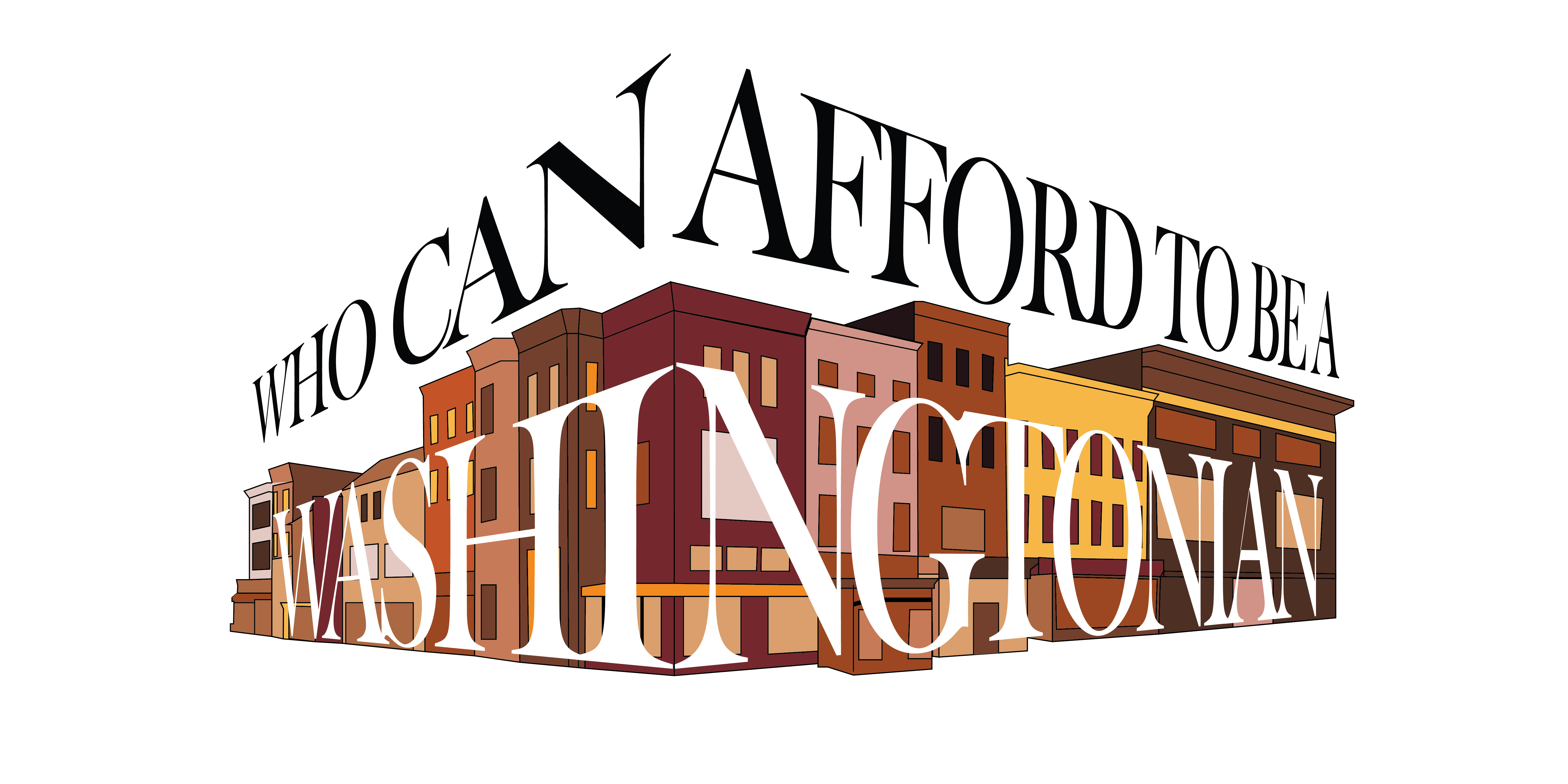Georgetown students might know the U Street corridor for its trendy boutiques and rooftop bars that have hosted many a club formal. But before the vintage stores and fusion restaurants, this stretch of D.C. was known as Black Broadway. From the early 1900s to the 1960s, U Street was home to hundreds of black-owned businesses, including the first African American chapter of the YMCA and jazz clubs frequented by Duke Ellington, Chuck Brown, and Billie Holiday.
Now, however, a shrinking number of black-owned businesses can afford rising rent prices, and are being replaced by new storefronts catering to the interests of whiter, wealthier, and younger urban professionals. U Street is not alone in this phenomenon. In neighborhoods across the District, gentrification is transforming the economic and demographic landscape, and D.C.’s black history is disappearing in the process.
For centuries, black residents have been central to the development and culture of the city. In 1957, D.C. became the first large American city with a majority African American population, earning the nickname “Chocolate City.” Residents now joke that because of a growing white presence, the District is more like “Latte City.”
While the Office of Planning reports that black residents still comprise 45 percent of the population, it’s a far cry from the peak of 71.1 percent in 1970. Educators and policymakers are racing to protect and recognize this history, hoping to bring it to the attention of a new generation of Washingtonians.
Councilmember Kenyan McDuffie (D-Ward 5) introduced a bill on Feb. 4 that would add an African American history and cultural studies course to the D.C. Public School (DCPS) curriculum. In a statement to the Voice, McDuffie wrote that DCPS would be remiss not to teach students the topic in detail.
“Ward 5 residents recognize that American history is incomplete without the inclusion of the struggle, accomplishment, and contributions of African Americans,” the statement said.
With the African American Cultural Studies and Inclusion Amendment Act, McDuffie hopes to foster a deeper understanding of the importance of African American history, from humanity’s origins in Africa to enslavement to the ongoing fight for socioeconomic equality in the United States.
“Teaching of African American history to our students will instill pride, help to close the achievement gap, and create a heightened sense of cultural awareness, diversity, and sensitivity,” McDuffie wrote.
If passed, the act will require the Mayor’s Office on African American Affairs to coordinate with DCPS, the Office of the State Superintendent of Education, and other relevant stakeholders to develop a curriculum model.
Ying Ying Mei (SFS ’22) has seen the loss of this history happen in real time. Since she moved to the city in 2008, she’s lived in Shaw and Chinatown, two of D.C.’s fastest gentrifying neighborhoods. “It used to be a predominantly black city,” she said. “But now [with] all the development and gentrification, those cultural enclaves are being displaced.”
Gentrification isn’t just about the proliferation of pricey salad shops and craft breweries. According to a 2019 study, gentrification in D.C. has pushed more low-income residents out of their homes than almost anywhere else in the country. Between 2003 and 2013, 20,000 black residents were displaced from D.C.
A combination of factors such as income inequality, suburbanization, and the lingering effects of the 2008 financial crisis are pricing black and low-income Washingtonians out of their old neighborhoods in Shaw, Logan Circle, Chinatown, and the U Street and H Street corridors.
Jasia Smith (SFS ’22) knows the history of these places well. A lifelong Washingtonian, she grew up in neighborhoods many Georgetown students would have trouble finding on a map.
“Georgetown’s one of the richest communities in the city,” she said. “If you’re around this area most of the time, you’re not going to get that culture and that experience that the entire city has to offer.”
According to 2018 data from the Business Improvement District, the median home value in Georgetown is $1.17 million. But the history of Georgetown’s wealth—and who owns it—is complicated. In some ways, it set the tone for current changes disrupting other parts of the city.
Most of Georgetown’s first black residents were brought to the neighborhood against their will. Enslaved people were auctioned in the basement of 3276 M Street, where a trendy flea market will replace Dean and Deluca next year. After the city abolished slavery in 1862, Georgetown’s black population jumped from 1900 to nearly 5000 by the end of the 1880s.
Black doctors, lawyers, bankers, shopkeepers, and craftsmen made up between 30 and 40 percent of the Georgetown population well into the 1930s and 1940s. They founded the city’s first black church, Mount Zion United Methodist Church, and established its first desegregated park by petitioning for the removal of “For Coloreds Only” signs in Rose Park. Mount Zion still stands on 29th Street, but much of the community that founded it no longer lives close enough to walk to Sunday services.
These historical sites are most of what remains of Georgetown’s black history. A series of legislative acts, including the Old Georgetown Act of 1950 that designated the neighborhood a historic district, tightened property regulations and subsequently drove up housing prices. Many black Georgetowners were priced out and by 1960, they accounted for less than 9 percent of the population.
Smith has observed similar trends in the communities where she and her friends grew up. She and her siblings are third-generation residents of Deanwood, a historically black neighborhood east of the Anacostia River. Her grandparents have lived in the same Deanwood house for decades, but Smith says this kind of stability is the exception, not the rule.
“They’ve had that house since my dad was a kid, which is really rare,” she said. “A lot of black families can’t afford to live in the neighborhoods that their parents and grandparents lived in.”
Regardless of whether D.C. public school students have personal experiences like Smith’s, they are required to learn about them in the classroom; among the DCPS graduation requirements is one year of D.C. history. The curriculum can vary from school to school, but themes of economic and demographic change crop up throughout the District’s history.
“The way my high school did it was definitely very focused on gentrification,” Smith said. She laughed. “And go-go. And Chuck Brown.”
Pioneered by Brown in the 1970s, go-go is a percussive subgenre of funk that soundtracked D.C.’s years as the Chocolate City. Last spring, it took on a new importance to black Washingtonians when a Metro PCS store owner in Shaw was threatened with a lawsuit for playing go-go music from his storefront. To many black residents, the incident was a reminder of how few store owners in the rapidly gentrifying neighborhood still sing along to Chuck Brown.
Anti-gentrification activists flooded the neighborhood in protest and gathered more than 80,000 signatures on a petition demanding the store owner be allowed to keep playing go-go. The campaign #DontMuteDC trended on Twitter.
A few months later, in June 2019, McDuffie introduced a bill to make go-go the official music of the District. On Feb. 19 of this year, Mayor Muriel Bowser signed the act into law after it was passed unanimously by the D.C. Council. “Go-go music encapsulates the range of personal experiences in local communities around the District and expresses them in a unifying force,” the act reads.
Fights for the city’s history and culture can seem far away from Georgetown, where students encounter few reminders of the neighborhood’s black history. They might only venture off campus a few times a month and lack the historical background longtime Washingtonians have.
Associate Professor of Sociology Brian McCabe (SFS ’02) is working to bridge this gap between Georgetown students and the rest of the city. Through both his research and teaching, he tries to engage students on issues like gentrification and housing policy.
“What responsibilities do we have to the broader city?” he asked. “What do we owe Washington?”
McCabe initially housed these efforts in a gentrification seminar he taught in the fall of 2016. It covered a range of academic subjects but was mostly limited to the classroom. “What I realized in that seminar was that there was this sort of appetite and need to actually get out in the city,” he said.
In the spring of 2019, he decided to test a more experiential model, which tasked students with venturing into D.C.’s gentrifying neighborhoods and creating a semester-long project. Students mapped affordable housing in the District, wrote guides to responsible renting practices, and performed spoken word poems drawn from local histories.
McCabe is bringing together both parts into a six-credit gentrification course next fall. He says that students interested in the class and others like it tend to already have personal experience with gentrification.
“I think that if you’re from New York or you’re from Los Angeles or you’re from Chicago, those processes are happening in those cities as well,” he said. “I think a lot of students that aren’t from D.C. have adopted the city as their home.”
After more than a decade of living in the city, Mei says she considers herself a Washingtonian. “I have family here. I have friends here. I’ve built a life here,” she said.
In contrast, most Georgetown students are transplants. They move to D.C. for college, likely with little background on the city’s history or demographics. Center for Social Justice programs like the D.C. Schools Project and D.C. Reads Program introduce participants to some of the city’s low-income communities of color, but a relatively small portion of the student body is involved in the tutoring programs.
“They go into different wards of the city and engage with those communities and especially those communities that are disenfranchised,” Mei said of the programs. “But I think we could definitely do more.”
Georgetown’s insulation from the rest of the District is somewhat unusual for a university located in a big city. Several urban universities have research centers dedicated to the city in which they’re located. NYU boasts two such institutes, one for urban informatics and the other for policy. American University’s Metropolitan Policy Center aims to “demonstrate American University’s engagement in Washington, D.C.”
McCabe believes devoting some of Georgetown’s resources to establishing a D.C.-focused research center would encourage the university community to engage with local issues.
Backed by Georgetown’s resources and prestigious reputation, the center could produce research and policy recommendations on topics like housing, racial justice, and efforts to protect and commemorate D.C. history. “As a university, what we’re great at is doing research,” he said. “We should centralize that, and we should create an opportunity for students and for faculty to be involved.”
Many of Georgetown’s peer institutions, like the University of Pennsylvania, NYU, and Washington University in St. Louis, have some variation of an urban studies major. Georgetown currently does not offer a major or minor in the subject, which McCabe describes as “incredibly unusual.”
Without an institutionalized way to study urban issues, the onus to critically engage with the city falls largely on individual students and professors. “I don’t think every Georgetown student seeks that out, which is a big issue,” Mei said.
She urged Georgetown students from out of town to take the time to learn about D.C. history and culture. Mei emphasized the cultural losses associated with gentrification.
Her neighborhood in Chinatown-Gallery Place was home to a thriving Chinese American community until the 1990s, when a series of construction projects—including Capital One Arena—spurred a new wave of development and economic investment in the area.
Many local Chinese American business owners couldn’t keep up with rising prices. As of 2015, fewer than 300 Chinese residents remained in the neighborhood. “A lot of them just closed because of the high rents,” Mei said. “It’s super expensive to rent in Gallery Place, not only because there’s the Capital One Arena there, which draws in a lot of visitors, and all around the area is super developed with all these franchise businesses.”
McCabe argued that students need to reckon with these economic realities when they venture into neighborhoods like Shaw, Chinatown, and U Street. “I think the best thing I can tell Georgetown students is to be self-reflective, to be aware, to think about their role in those neighborhoods, and to learn as much as they can about the places that they’re living,” he said.
Only a sophomore, Smith is already thinking about how to navigate her old communities after she graduates from Georgetown. It’s not a topic she takes lightly.
“An apartment that I rent out with a friend as soon as I graduate [could be] where someone else lived, that was basically displaced,” she said. “It’s weird to think that I could be a part of the problem that has affected people I love and people close to me.”






[…] Georgetown Voice: “Gentrification isn’t just about the proliferation of pricey salad shops and craft breweries. According to a 2019 study, gentrification in D.C. has pushed more low-income residents out of their homes than almost anywhere else in the country. Between 2003 and 2013, 20,000 black residents were displaced from D.C.” […]
[…] Who Can Afford to be a Washingtonian? Gentrification isn’t just about the proliferation of pricey salad shops and craft breweries. According to a 2019 study, gentrification in D.C. has pushed more low-income residents out of their homes than almost anywhere else in the country. Between 2003 and 2013, 20,000 black residents were displaced from D.C. By Caroline Hamilton. February 28, 2020. Georgetown Voice. […]